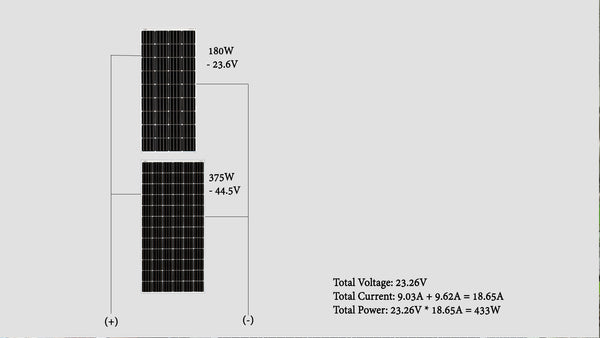With the rising popularity of solar systems in India, there has been a surge in the supply of solar panels in the market. It is not an uncommon scenario if a consumer will have panels of different brands, voltages, or ratings. In such a scenario, he will be most confused if he can use all of them together. In this article, we would like to highlight such a situation of the consumer.
When two or more solar panels are paired together, a user intends to increase the power output. However, he must be well versed in the pros and cons of doing so. Connecting together panels is an easy way to expand the whole solar system.
Lasted Updated: July, 2021
How to Wire Mismatched Solar Panels in Series and Parallel?

In the above diagram, it shows connecting different ratings of solar panels. Here are two numbers of solar panels of 180W and one number of shark solar panel of 440W. When we connect mixed solar panels, we are always aware about output voltage of solar panels. Here, the voc of 180W is 23.6V & the voc of 440W is 50V. The connection method of different ratings of solar panels is Series & Parallel connection both. An overall connection is working successfully. To become more confident, watch this video below:
Types of Solar Connection:
- Series Connection: Always increase the voltage
- Parallel Connection: Always increase the current (ampere)
- Mixed Connection: When required maximum voltage & ampere
Different Types of Situations
Situation 1: When we connect two solar panels in series:

For example, the left side solar panel is of 180W – 12V & right side solar panel is 375W – 24V. We should also know how to read the technical sticker of each solar panel, where we can get information such as:
180 Watt Solar Panels:
Voltage: 23.26V
Current: 9.03A
375 Watt Solar Panels:
Voltage: 44.5V
Current: 9.62A
After Series Connection:
Total Voltage = 23.26V + 44.5V = 67.76V
Total Current = 9A
Total Power = 67.76V * 9A = 609W
In a series connection, the positive terminal of a solar panel to the negative terminal of the next solar panel. This needs to be continued until you have one last free positive and negative terminal which is to be connected with the inverter or charge controller of the solar system.
Also, in series, the total output current of the solar array is the same as the current passing through a single panel, but the total output voltage is the sum of the voltage on each of the solar panels. These panels should preferably be of the same type and power rating. Also, be careful of using panels with the same current rating. Connecting solar panels in series is generally used in grid-tied solar systems.
Situation 2: When we connect two solar panels in Parallel connection

180 Watt Solar Panels:
Voltage: 23.26V
Current: 9.03A
375Watt Solar Panels:
Voltage: 44.5V
Current: 9.62A
After Parallel Connection:
Total Voltage = 23.26V
Total Current = 9.03A + 9.62A =18.65A
Total Power = 18.65A * 23.26 = 433W
In parallel connection, the positive terminals of all panels are joined together, and negative terminals of all panels are connected together. In the end, you will be left with one positive and negative terminal each which will be connected to the inverter or charge controller of the solar system.
In this connection, the output voltage of the solar system will be the same as the voltage of a single panel. The total output current is, however, the sum of the currents passing through each panel. Be careful of using panels with similar ratings because the lower the rating, the higher will be the loss of power. Also, be mindful of using panels with the same voltage rating. A parallel connection is applicable for off-grid systems.
Practically Tested

I, myself have installed mismatched panels at my home and nothing is wrong with them. I, earlier was using 5 panels of 12 volt 170 watt (around 8 amps) each in parallel configuration because I then had a 12 volt inverter. Now I’ve switched to a 3.2kW grid tied hybrid inverter that requires minimum 150 volts DC to start conversion. So then I added 4 more panels of 280 watt, 24 volt each (8.3 amps). All these 9 panels are installed and connected in series configuration. I receive around 250 solar voltage at inverter. Solar panels produce more voltage than their rated voltage, they’re usually 150%. In series connection, they are added up and amperes remain at everage. In my case there was no big difference between amperes of both panels. Everything working fine, never faced any problem regarding mismatched panels.
Before installing these panels I was worried a little as many people tried to frighten me about adverse effects but before installing I carried out a little experiment with 2 small mismatched dry batteries. After this experiment I came to the conclusion that installing panels having 2 different voltages are possible and there would be no fuss around.
Source: Quora
Conclusion
Mixing different solar panels is not recommended, but in some situation as like Mr. Naeem Fraz’s situation, you can do. Wiring together panels of different brands is not much of an issue as pairing together panels of different electrical readings. If doing so a user must be well aware of the panels’ electrical parameters like voltage, wattage, etc. and the repercussions of doing so. Other factors such as temperature, solar cells’ temperature, and solar irradiance also play a huge role in determining the total power output.



















